As u 'n aanlynwinkel wil begin, is u waarskynlik besig om verskillende e-handelsoplossings te ondersoek. Daar is tonne opsies daar buite, twee daarvan is Shopify en Joomla. Alhoewel elke oplossing jou in staat stel om 'n aanlynwinkel te bou, is dit baie verskillende raamwerke. Dit gesê, kom ons delf hierin Shopify vs Joomla-oorsig.
Hopelik sal ons jou teen die einde gehelp het om tot onder te kom wat, indien een, die regte pas vir jou is ...
Wat is Shopify?
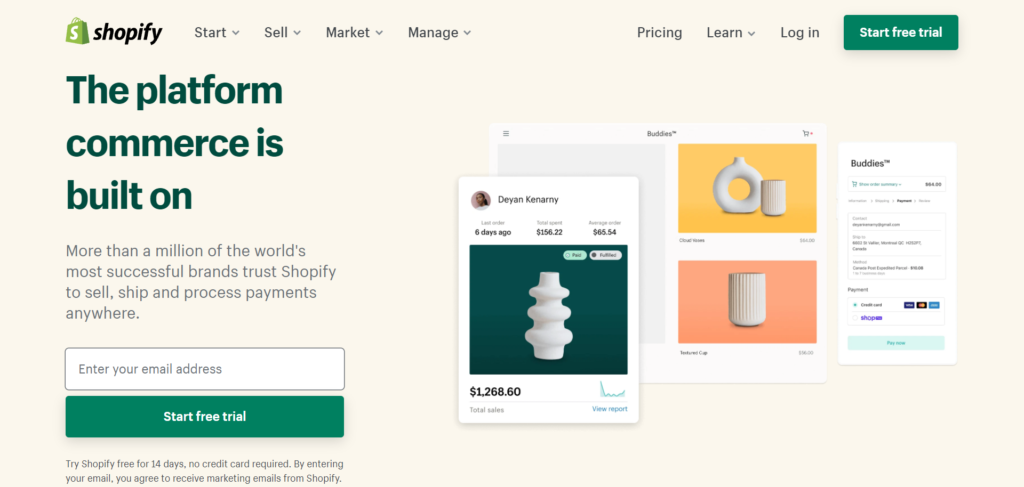
In kort, Shopify is 'n SaaS wat gebruikers in staat stel om 'n aanlynwinkel te ontwerp en bekend te stel met hul volledige funksies content management system. Jy kan jou hele werf op Shopify, so dit is nie nodig om na te vors en jou eie webhosting te koop nie.
Shopify kom ook met 'n POS, wat jou toelaat om te verkoop in fisiese plekke met behulp van Shopifyse verkooppunt-toepassing. Hierdie sagteware sinkroniseer voorraad oor jou aanlyn en vanlyn verkoopspunte, wat jou toerus om voorraad te bekyk en te bestuur vanuit die gerief van jou Shopify dashboard. As sulks, Shopify is 'n uitstekende keuse vir entrepreneurs wat beide aanlyn- en baksteen-en-mortier besighede bedryf.
👉 Lees ons volledige Shopify hersien.
Wat is Joomla?

Sit eenvoudig, Joomla is 'n gratis oopbron-inhoudbestuurstelsel wat jy kan gebruik om webinhoud te skep en te publiseer.
Jy kan 'n blog, besigheidswebwerf, intranet, gemeenskapswebwerf, ens. saamstel. Dit maak nie saak die kompleksiteit van jou webontwikkelingsprojek nie; Joomla se raamwerk kan dit hanteer.
Boonop spog Joomla ook met 'n view-controller-webtoepassingsraamwerk, wat jy apart van Joomla se CMS kan gebruik om robuuste aanlyntoepassings te bou.
Oor die dekades het Joomla verskeie toekennings verwerf, insluitend Beste Gratis CMS van die CMS Critic People's Choice Awards in 2020, die Beste Oopbron Aansoek in 2012 van Infoworld Bossie Awards, en die 2de Naaswenner Hall of Fame CMS in 2010 van Packt Oopbron-toekennings.
Joomla vs Shopify: Webwerf Sjablone
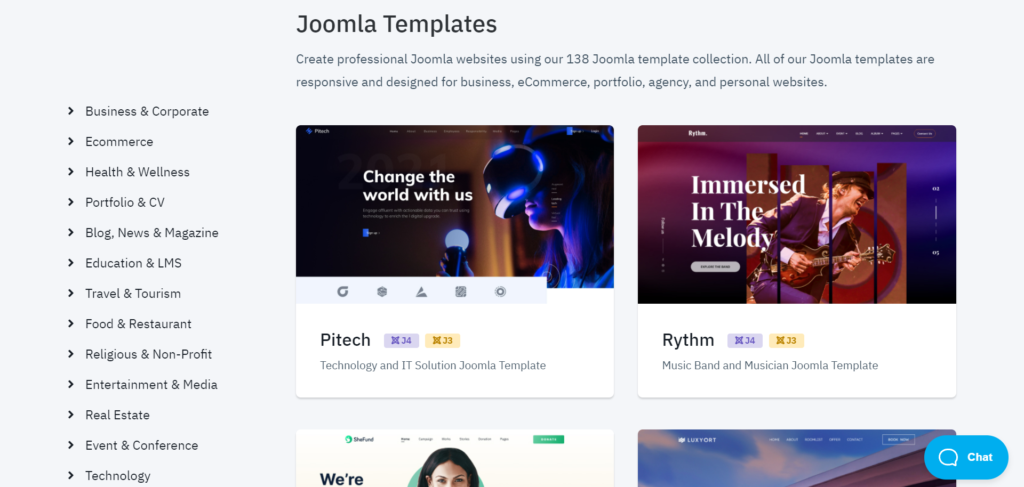
Om 'n professionele sjabloon te hê om van te werk, maak die proses baie makliker wanneer dit by webontwerp kom. Met dit in gedagte, kom ons kyk wat Joomla en Shopify in hierdie arena te bied:
Joomla
tegnies, Joomla bied nie 'n toegewyde webwerf-sjabloongids aan nie. Baie derdeparty-ontwikkelaars het egter Joomla-temas geskep wat jy kan aflaai en gebruik – sommige is gratis, terwyl ander betaal word.
Aangesien daar geen amptelike keuringsproses vir hierdie sjablone is nie, sal jy jou eie navorsing moet doen om kwaliteit, aanpasbaarheid, die netheid van die kode, ens.
Shopify
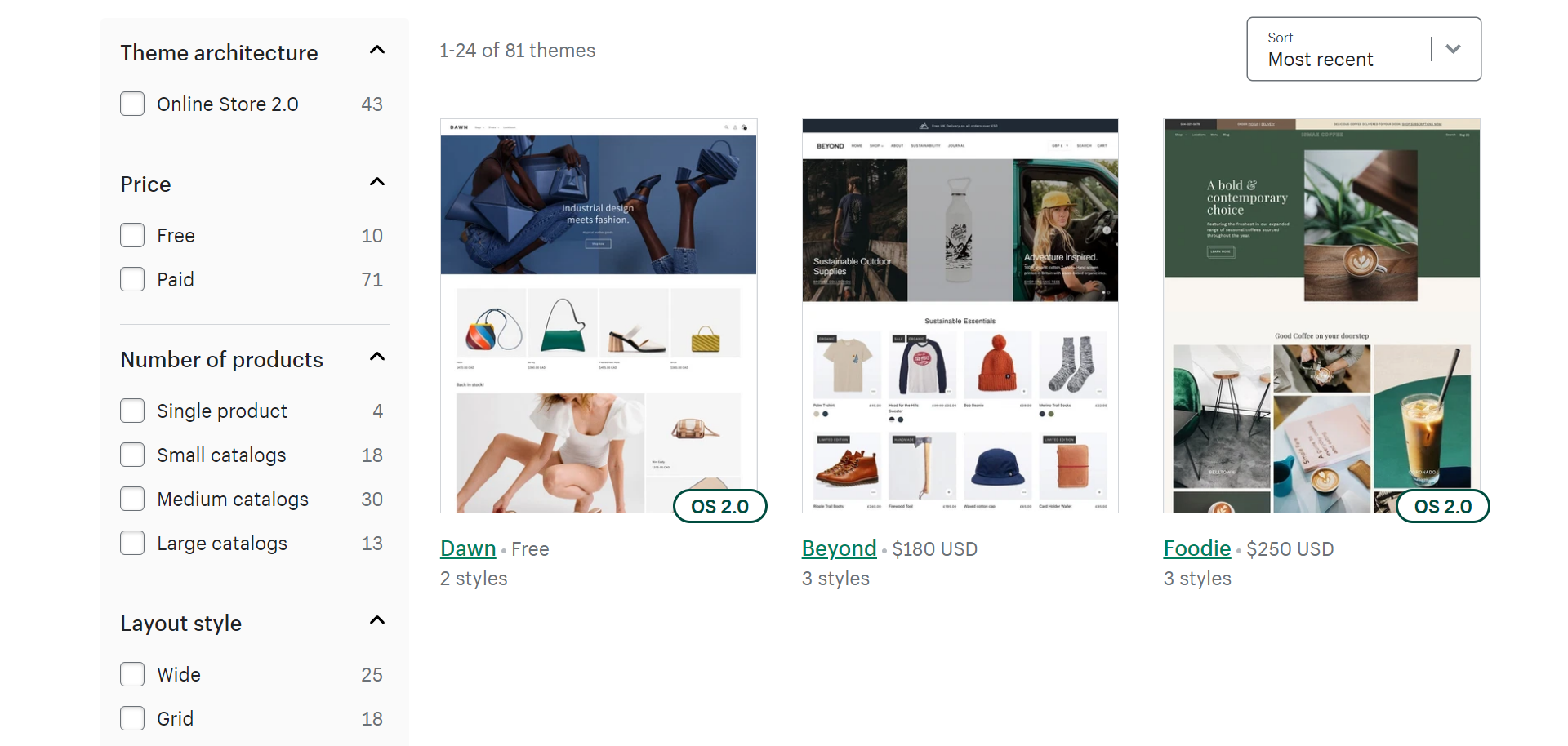
In kontras, Shopify bied gebruikers sy eie toegewyde temawinkel, met tonne opsies om van te kies. Daar is tien gratis temas en 71 betaalopsies. Almal wat selfoonvriendelik is, spog met skoon kode en is maklik aanpasbaar deur gebruik te maak Shopifyse webwerfredakteur. Jy sal selfs meer aanpassingsvryheid geniet as jy met 'n mate van kennis van die programmeertaal "Liquid" spog.
Shopify vs Joomla: Gebruikersvriendelikheid en gebruiksgemak
In hierdie deel van die resensie sal ons vinnig kyk hoe maklik Joomla en Shopify moet gebruik word:
Joomla
Joomla se agterkant is redelik skoon, wat die skep en publisering van webblaaie en blogplasings relatief intuïtief maak. Kies net 'n afdeling, skryf jou inhoud en druk publiseer.
Om voordeel te trek uit meer gevorderde kenmerke, sal jy egter die kennis nodig hê om jou gewenste ontwerpe/funksionaliteit te kodeer. Alternatiewelik sal jy voorbereid moet wees om verskeie Joomla-uitbreidings na te vors, af te laai en te gebruik. Maar soms hierdie plugins is glo verouderd en karig. Dit maak dit des te belangriker om potensiële byvoegings na te vors voordat dit afgelaai word.
Shopify
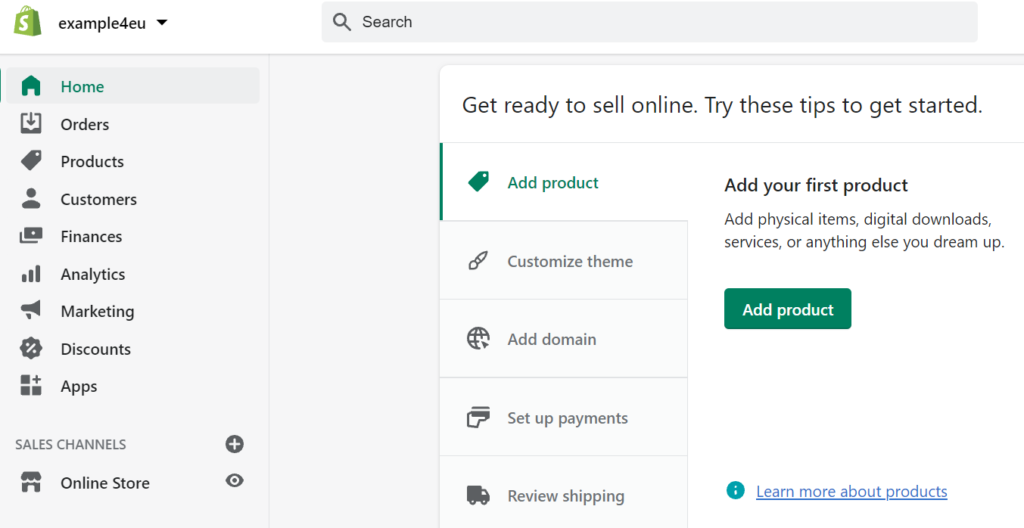
In kontras, Shopifyis baie makliker om mee te begin. Jy het geen tegniese kennis nodig om die meeste uit te maak nie Shopifyse uit-die-boks-kenmerke. In plaas daarvan moet jy net 'n skep Shopify rekening en kies jou voorkeurprysplan; daarna is jy vry om die grond te slaan. Van daar af, Shopifyse admin area is ongelooflik gebruikersvriendelik.
As jy nuut is met e-handel, is daar 'n goeie kans dat jy niks nodig het nie plugins, om mee te begin. Soos u egter u besigheid begin groei en skaal, is daar tonne byvoegings beskikbaar Shopifyse appmark.
Shopifyse kernkenmerke
Soos ons so pas verwys het, Shopifyse reeks ingeboude kenmerke is ongelooflik uitgebreid, so ons sal nie tyd hê om hulle almal hier te dek nie.
Maar aangesien daar 'n goeie kans is dat jy hierdie vergelyking lees om jou te help besluit watter e-handelsplatform die beste vir jou is; ons sal fokus op Shopifyse winkelfront, bemarking en SEO-funksies:
Om mee te begin, is daar meer as 70 professionele en aanpasbare temas om van te kies, geskep deur wêreldwyd bekroonde ontwerpers, insluitend Happy Cog, Clearleft en Pixel Union. Gekombineer met Shopifyse maklik-om-te gebruik webwerf-redigeerder, is dit maklik om aan jou tema se instellings en estetika te peuter om jou visie tot lewe te bring. As jy boonop 'n paar koderingsvaardighede het, kan jy toegang tot jou winkel se HTML en CSS kry om elke aspek van jou webwerf te verfyn.
Shopify bied gebruikers ook 'n robuuste blog-enjin. Van hier af kan jy jou artikels skryf, publiseer en kategoriseer. U kan lesers ook toelaat om kommentaar op blogplasings te lewer, bespreking aan te moedig en natuurlik hierdie opmerkings te modereer. Jy kan ook gebruik Shopifyse blogplatform om lookbooks te skep – wat veral handig te pas kom as jy 'n modehandelsmerk bedryf.
Jy sal ook bly wees om dit te hoor Shopify kom met 'n mobiele handel-inkopiemandjie, wat webwerfbesoekers in staat stel om jou winkel op rekenaar- en mobiele toestelle te sien.
Wat SEO betref, Shopify ondersteun baie beste praktyke vir soekenjinoptimalisering. U kan byvoorbeeld meta-titels wysig, en etikette en kliënte kan produkresensies laat. Om nie te praat nie, Shopify genereer ook 'n sitemap.xml van jou produkte, webblaaie en blogplasings – wat dit baie makliker maak vir soekenjins om jou webwerf dienooreenkomstig te skandeer en te rangskik.
Terwyl ons besig is om jou bereik uit te brei, Shopify gee jou ook $100 se Google-advertensiekrediete as jy $25 saam met Google spandeer.
Ook almal Shopify webwerwe integreer met verskeie sosiale media platforms, insluitend Pinterest, Instagram, Facebook, Twitter, en Tumblr. Meer spesifiek, op Facebook kan kopers deur produkte blaai en produkte koop sonder om Facebook ooit te verlaat.
Laastens, as jy verkope wil verhoog, Shopify maak dit maklik om afslagkodes te genereer en geskenkbewyse te verkoop om handel te lok.
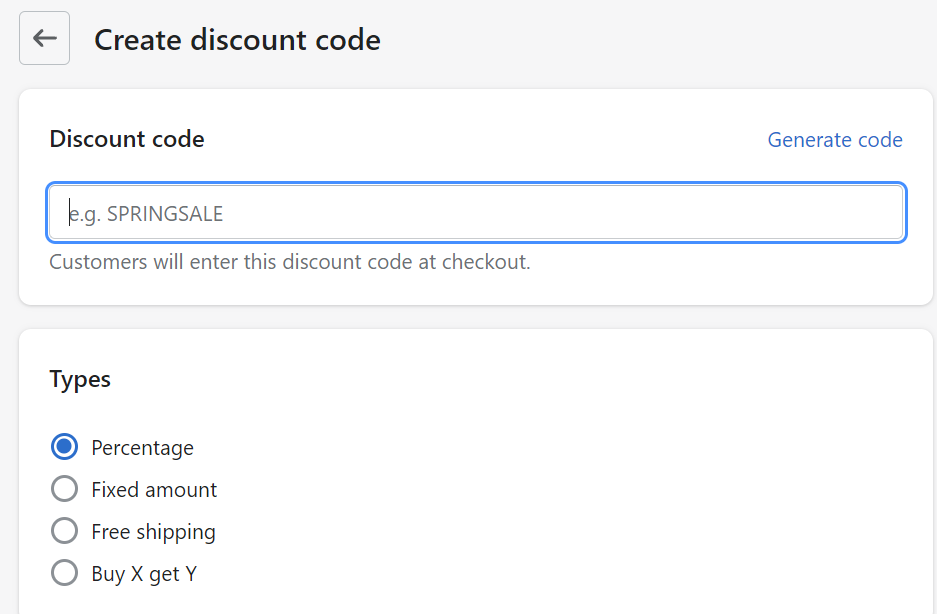
Joomla se kernkenmerke
Noudat ons gedek het Shopifyse mees noemenswaardige kenmerke, kom ons kyk na Joomla's:
Daar is duisende sjablone van hoë gehalte beskikbaar wat deur derdeparty-ontwikkelaars geskep is, waarvan baie gratis is en met 'n grafiese gebruikerskoppelvlak (GUI) kom. Dit bemagtig jou om hul kleure, lettertipes, uitlegte en kenmerke te verander sonder om 'n enkele reël kode te skryf.
Jy kry ook toegang tot 'n WYSIWYG-redigeerder (Wat jy sien is wat jy kry). Hierdie styl van webwerfbouer maak dit baie makliker om teks, beelde en formatering te skryf en te redigeer. Boonop is daar verskeie vooraf geïnstalleerde modules beskikbaar wat jou in staat stel om gewilde artikels, nuwe plasings, nuusflitse, verwante artikels, ens, ten toon te stel. Dit maak Joomla 'n uitstekende keuse vir bloggers!
Van gepraat, bloggers kan hul inhoud in kategorieë en etikette organiseer,
skep 'n RSS-stroom uit hul inhoud, en vertoon 'n eksterne nuusstroom op jou webwerf. Jy kan ook besoekers voorsien van 'n soekbalk om hulle te help om jou webwerf te navigeer.
Jy kry ook toegang tot out-of-the-box SEO en SEF kenmerke. U kan byvoorbeeld metadata wysig en bladsye vir sleutelwoorde optimeer. Dit bied ook die infrastruktuur wat u nodig het om duidelike en konsekwente werfkaarte te skep. Na berig word, maak Joomla dit ook redelik maklik om URL's te herlei wanneer dit nodig is en kan u webwerf se laaitye versnel met kas.
Nog een van Joomla se sleutelkenmerke is dat dit veeltalig is – in werklikheid ondersteun dit soveel as 70 tale.
As jy jou Joomla-werf wil verdien, kan jy baniere en ander webwerf-advertensies byvoeg.
As jy 'n klein span het, kan jy verskeie gebruikers registreer en hul toestemmings bestuur. Van daar af kan jy ook boodskappe tussen admins stuur.
Laastens, as jy Joomla se funksionaliteit wil uitbrei (en nie kan/wil kodeer nie), is daar meer as 8,000 XNUMX uitbreidings op Joomla se uitbreidingsgids – extensions.joomla.org. So, jy sal seker 'n byvoeging vind wat by jou behoeftes pas!
Shopify en Joomla se voor- en nadele
Noudat ons die basiese beginsels behandel het, kom ons kyk na Shopify en Joomla se voor- en nadele:
Shopifyse voordele:
- Shopifyse platform is eenvoudig om te gebruik.
- Shopifyse temas is pragtig en selfoonvriendelik
- U kan veldtogte vir verlate karretjies op alle planne stuur, wat skaars is onder platforms wat soortgelyke pryspunte hef.
- Shopify kan outomaties VSA-, Kanadese-, EU- en VK-belasting bereken.
- Shopify kom met gratis, ingeboude e-posbemarkingsfunksies wat jou in staat stel om tot 2,500 XNUMX intekenare te stoor.
- Shopifyse verkooppuntaanbod is redelik omvattend.
- Jy kan maklik verleng Shopifyse funksionaliteit te danke aan sy groot verskeidenheid van plugins beskikbaar
- As jy Shopify Payments, sal jy nie ekstra transaksiefooie gehef word nie.
- Shopify ondersteun baie derdeparty-betalingspoorte, insluitend gewilde name soos PayPal.
- Jy kan probeer Shopify gratis vir 14 dae.
ShopifyNadele:
- Alhoewel jy 100 produkvariasies kan skep, strek dit net oor drie produkopsies – dit wil sê grootte, kleur, styl, ens.
- Jy kry net toegang tot professionele verslagdoening funksionaliteit met ShopifyDit is duurder planne.
- Shopify ondersteun nie meer 'n inheemse Mailchimp-integrasie nie.
- Alhoewel Shopifyse ingeboude e-posbemarkingsfunksie is handig, dit is steeds redelik basies.
Joomla se voordele:
- Joomla is 'n open source platform, sodat jy jou webwerf se kode met gemak kan verander en versprei as jy oor die kodering beskik.
- Joomla's is gratis om af te laai en te gebruik
- Dit is maklik om bloginhoud te skep – om 'n blogplasing te skryf voel meer soos om 'n dokument in 'n tradisionele woordverwerkingsprogram te skep as om 'n koderingsagteware te skep.
- Daar is baie selfhelpondersteuning beskikbaar. Joomla se aanlyn gemeenskapsforums is redelik aktief en het as sodanig tonne ondersteuningstutoriale en materiaal gevul.
- U kan met spanlede saamwerk deur gebruikerstoegang aan hulle te gee.
- Joomla is 'n veeltalige platform.
Joomla se nadele:
- Joomla kom met 'n steiler leerkurwe as Shopify. Oopbronraamwerke is so 'n bietjie van 'n tweesnydende swaard, aangesien om aan die gang te kom en jou eie ontwerpe te skep 'n bietjie meer tegniese kennis vereis.
- Sommige gebruikers rapporteer versoenbaarheidskwessies met sommige van Joomla's plugins.
- Sommige van Joomla se beste sjablone het 'n prysetiket.
- Joomla het nie 'n toegewyde kliëntediensspan wat jy kan kontak nie
Shopifyse pryse
Laastens, kom ons kyk vinnig na hoeveel Shopify costs:
Basic Shopify
Vir $29 per maand is dit die beste vir diegene wat 'n nuwe e-handelswebwerf wil begin en af en toe persoonlik verkoop.
Shopify
Vir $ 79 per maand is die Shopify plan is die beste geskik vir besighede wat hul aanlyn- en/of persoonlike bedrywighede wil laat groei.
Advanced Shopify
Hier spring die prys aansienlik tot $299 per maand. Gevolglik is hierdie pakket die beste geskik vir groter ondernemings wat hul besigheid wil skaal met gevorderde verslagdoeningsfunksies.
Joomla se pryse
Joomla is heeltemal gratis om af te laai en te gebruik. U sal egter u eie webhosting en domeinnaam moet koop.
Joomla vs Shopify: Ons finale uitspraak
So, daar het jy dit, ons Joomla vs Shopify vergelyking. Kortom, as jy nie enige kodering of tegniese vaardighede het nie, Shopifyis makliker om te gebruik, op te stel en jou e-handelbesigheid te begin. Maar die beste van alles, dit pas by beginners en klein besighede en diegene wat hul bedrywighede wil groei en skaal.
Gestel egter jy is 'n webontwikkelaar wat op soek is na 'n oopbronraamwerk. In daardie geval sal Joomla jou voorsien van die soort ontwikkelaarvriendelike raamwerk waarna jy soek.
So, watter (indien een) van hierdie platforms, dink jy, pas die beste by jou behoeftes? Of oorweeg jy ander alternatiewe soos WordPress en WooCommerce, Virtuemart, Wix, BigCommerce, Drupal, of Magento? Hoe dit ook al sy, vertel ons alles daarvan in die kommentaarblokkie hieronder!




Kommentaar Kommentaar